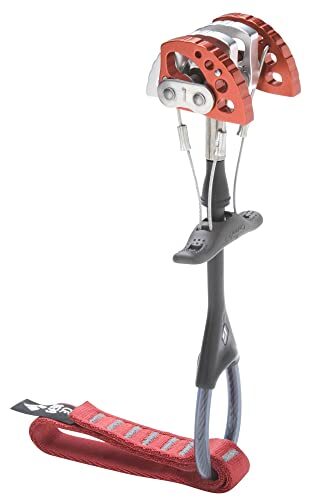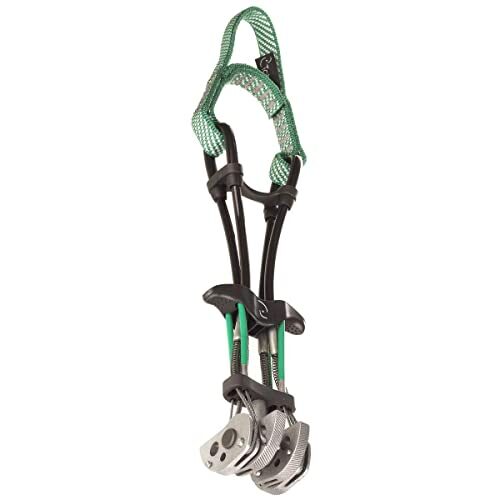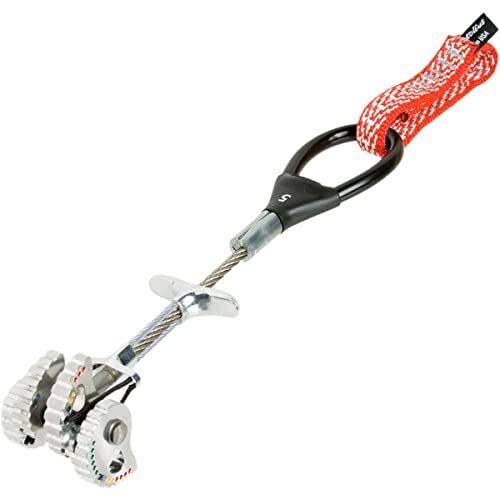Your cart is currently empty!
{ TOP 7 } Best Climbing Cams – 2020 Reviews
Views: 0
Once you start to trad climb, you’ll quickly find yourself investing in lots of camming devices, or cams. Officially called Spring Loaded Camming Devices, cams are inserted into features on a rock to provide protection as you move up the wall. When a cam is weighted, its opposing lobes cam outward to remain in place on the wall. A good cam placement will save you when you fall.
The thing about the best climbing cams is that they are expensive. Financial constraints (and the crippling fear of leading on your own gear placements) can create a barrier to entry for trad climbing. But if you’re brave enough and willing to invest in good gear, you can climb virtually any route you’d like, including some of the most famous faces on Earth that are only accessible by trad climbing.
Your rack will grow and change over time as you discover what types of climbs you prefer and lead more climbs to learn which types and sizes of cams best serve you. And we’re here to help you along in your trad journey by front loading some of your research and making our recommendations of the 7 best camming devices available on the market today.
Camming Device Buyer’s Guide
A single cam can easily cost upwards of $40, and a small rack should have 10-15 pieces, so you’ll no doubt be investing a good amount of money in your rack. Additionally, different crags will require different types and sizes of cams (a rack for climbing in Yosemite will look very different than one used in Indian Creek, for example). It’s important to know the types of cams available and which ones will put in the most work in the areas you climb in the most.
What to Look for in a Camming Device?
These are the key points to consider before buying a cam:
- Size: Be careful when you are building a rack of different brands of cams. There is no standardized size, so it’s important to pay attention to the size of each cam.
- Range: Another thing to consider when building your rack is your cam’s expansion range. This is how far the cam expands when the lobes are fully contracted to fully expanded. A wider expansion range means you can use one piece in a wider variety of placements, meaning you will need less piece overall, which means your rack is smaller and lighter (which is a very good thing).
- Weight: Even the smallest of trad racks is going to weigh much more than a sport climbing rack, so it’s important to consider the weight of the cams you are buying. There are many great ultralight options on the market today, but remember to never sacrifice performance for weight.
- Number of cam lobes: Most cams will have either three or four spring-loaded cam lobes. Four-lobe cams are the standard, and work well to provide as much contact with the rock as possible to make a secure placement. The downside to four-lobe cams is that they can be bulky. Three-lobe cams, on the other hand, offer a narrower profile to allow them to fit into tighter, smaller places. They tend to be lighter than four-lobe cams but can be prone to walking and feel less secure than four-lobe cams due to them making less contact with the rock.
- Slings: All cams come with a sling attached, but some have extendable slings. This is a good option for climbing meandering routes and reducing rope drag.
- Stem design: Older cams may have rigid stems, but the standard today is to have flexible cam stems. There are two main types of stems: single-cable and U-stems. Single-cable stems require you to use your forefinger, middle finger and thumb to pull the trigger, but they are slim enough to fit into smaller spaces than U-stems, which only require the forefinger and thumb to operate.
It’s relatively straightforward to start sport climbing. You can buy a rope, harness, and some quickdraws and, for the most part, be good to go. However, trad climbing is a whole different ball game. You still need all of those things, but you also have to buy cams (active protection), nuts (passive protection), and gear to make anchors. Here are a few of our recommendations for extras you should include in your rack.
- Cams: It is important to always research the gear required for any climbs you would like to attempt, as each route requires different sizes of cams. A good beginner rack might have 6-10 cams and 3-5 micro cams to start.
- Nuts: Nuts are a form of passive protection and are useful when placing gear in cracks. They’re also significantly cheaper than cams.
- Carabiners: Remember that cams don’t come with carabiners attached, so for every cam you buy, you’ll need a carabiner to connect it to the climbing rope.
- Quickdraws: Don’t forget your draws! Sometimes there are bolts that you can clip into or you can use them to extend your cam placements.
- Slings: Slings are also a nice way to extend your placements.
- Cordelette: You can buy one or make your own, and use it to build anchors.
- Locking carabiners: It’s good to have at least 3-4 locking carabiners to use for belays, building anchors, and to auto block your rappel.
- Nut tool: These come in handy for the follower to easily remove any gear that may have walked or got stuck in the rock.
Now that we’ve covered how to choose a camming device, it’s time for the reviews! Here are our recommendations for the 7 best cams on the market today.

If you’re looking for an all-around well performing cam that won’t break the bank and will get plenty of mileage, the Black Diamond Camalot is a great option for you. These cams are durable, affordable, and come in a wide range of sizes. They are great for beginners and experienced trad climbers alike, as they come in handy on any rack and last for years.
Black Diamond Camalots have a double-axle design that gives them a larger expansion range than other cams on the market. The cable loop and trigger are easy to use, and the sings are large enough to grab with gloves on. These are the (self proclaimed) gold standard for camming units, and we couldn’t agree more.
- Affordable
- Durable
- Available in a wide range of sizes
- Heavy compared to modern lightweight options

Whether you’re aid climbing up El Capitan or working a trad line in Basque Country (where these cams were created), having a few Totem cams in your rack will help you make bomber placements in difficult situations. Totem cams have a unique ability to engage only two lobes at a time using their patented technology. This means you can use them to make weight-only placements while aid climbing. They come in a wide variety of sizes, even small sizes to place in tiny pockets and holes that other cams just wouldn’t fit.
A number of additional features make this cam well-suited for any big wall adventure, including large, flat cam heads to make cleaning easier, flexible dual stems that can be placed horizontally and vertically, and a trigger large enough to use while wearing gloves.
- Unique design allows for more placements
- Great for trad, aid climbing, and big walls
- Can fit in small cracks and pin scars
- Expensive
- Often out of stock

Metolius’s offset cams have different sized lobes on one side than the other (two small lobes and two large ones) to increase the range of possible placements. These cams will work well in pin scars or flaring cracks, and also come in handy when aid climbing. They are lightweight (40% lighter than conventional cams), secure, and color-coded by size.
- Lightweight
- Able to place in pin scars and flares
- Lobes aren’t anodized to coordinate with color-coded slings

Fixe Hardware’s Alien Cams are small enough to protect your climb in placements that other cams just can’t. Their light, flexible, and durable. They are available in six regular sizes and five offset sizes to protect pin scars and horizontal or flared cracks. Some people complain that they don’t feel as secure as other cams, but if you’re on a route that requires small cams, then they are sometimes the only option.
- Flexible stems
- Small enough to fit in pin scars and flared cracks
- Offset option
- Expensive
- Not very versatile & durable
- Smallest three sizes are rated to 7 kN and under

If cost is a limiting factor, then the Trango Flex Cams are a good option for building your rack. They are lightweight, color-coded, have adjustable slings, and are cheaper than other cams. They’re definitely not the best cams you can buy, but they are cheaper than most other options and just as safe. The major complaint with the Flex Cams is that they are prone to walking, which can become a problem if they end up getting stuck in the rock or if they move so much that the placement is no longer secure. That being said, they are still an excellent option for people on a shoestring budget or for those that are looking for a few quality, affordable cams to test the waters and see if trad climbing is for them. If you are part of the second camp and decide to upgrade your rack later, you can still use these for doubles (or you can buy them new to use as doubles) in places that require multiple cams of the same size, like Indian Creek.
- Lightweight
- Affordable
- Wide range of sizes
- Durable
- Prone to walking
- Not as high-end as other options available

Wild Country Friends have been around since 1977. Over the course of time, they have evolved to meet modern climbing standards and needs. The new Friends are lightweight, ergonomic, and are available in standardized sizes to match the Black Diamond Camalot and DMM Dragons. They even come with an adjustable sling to minimize the need to carry additional quickdraws on meandering routes, which is a huge weight saver.
- Lightweight
- Adjustable slings
- Ergonomic thumb loop
- Smaller size range than other cams
If you’re climbing in wide-crack meccas like Yosemite Valley or Vedauwoo, you may find that your traditional rack stops short as crack widths widen. This is where Valley Giants cams come in to play. These oversize cams are available in two large sizes to fit cracks from 5.7 inches to 12 inches. They are designed like regular cams and are strong enough to use in belays, hanging bivouacs and as rescue anchors.
- Sturdy
- Reliable
- Designed like regular cams
Now that we’ve gone over the different types of the best climbing cams and their best uses, you can make confident decisions as you begin to build your rack! Once you start trad climbing, you’ll quickly notice that your rack may never be “complete.” That’s okay! As long as you do your research on each route you plan to climb, you can always buy any more missing pieces as needed. Also remember that your partner may have some of the pieces that you are missing, so it’s always a good idea to share pieces to make sure you have enough for your climb.